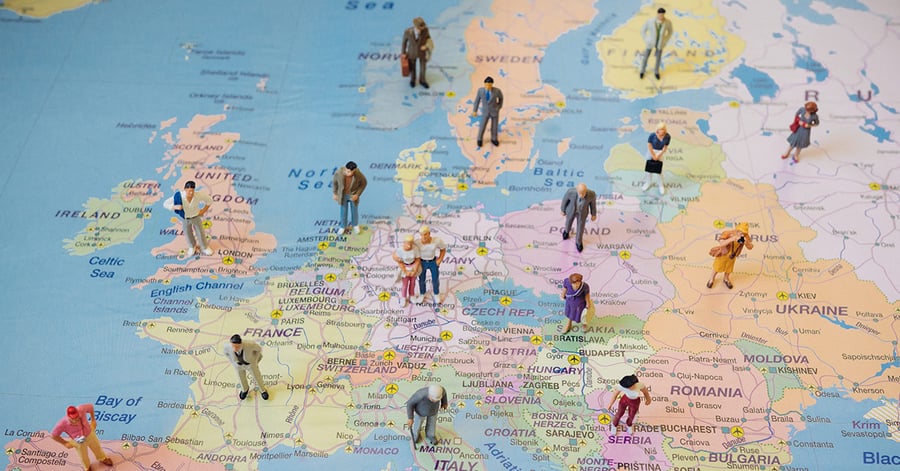
- Home
- Global Payroll
- The Impact of Cross-Border Employees on Payroll
The Impact of Cross-Border Employees on Payroll
Impact of Cross-Border Employees on Payroll | Ramco
9:47
Published :

Organizations worldwide are crossing multiple geographical boundaries and expanding their operations’ horizons. They are seeking to tap the foreign markets and get access to their skilled human resources. However, on their lookout to harness the global talent pool, they wrestle with the complexities of maintaining a structured cross-border payroll system that makes accurate and timely payments to their globalized workforce.
This article highlights the impact of recruiting cross-border employees on the payroll and tax processing challenges. It also suggests sound payroll solutions to reduce the complexities.
At the onset, let us take a hypothetical example to understand the concept of cross-border employees. XYZ is a multinational organization with offices in Europe and the US. Mr. A works in the Europe office and Mr. B in the US office of the same organization. Here, Mr. A and Mr. B are the cross-border employees of company XYZ.
The complexity of hiring cross-border employees surfaces as it necessitates creating an intricate system that regulates all payroll-related functions for all geographical locations. Besides performing the arduous task of managing the global workforce, the HR and payroll departments face the following challenges
There, thus, arises the need to design and execute a global payroll and tax system that administers the salary and wage disbursement of the geographically dispersed workforce.
Accelerating digitization and globalization has narrowed the workspace gaps in the business world. A massive transformation in business practices and employee work patterns was further brought by COVID-19. Together, these factors have coaxed organizations to hire talent across borders. Consequently, the HR and payroll services teams now have stretched out to multiple geographies, making them the intricate processes of transnational organizations.
Nonetheless, pre-covid or post-covid, the complexities of cross-border employees have practically existed forever. The administration of global payroll compliance with multiple pay scales and currencies has always been a daunting task, even during the pre-covid times.
The last two years of the pandemic have contributed to the tremendous growth of remote or virtual working setups. The new workplace transformation has further compounded the global payroll complications of disbursing payments to a geographically dispersed workforce in multiple currencies.
Global payroll is a centralized process of computing and administering payment of employee remuneration (inclusive of benefits, bonuses, and taxes) in different countries in compliance with their local regulations. Let us understand the complexities of managing a global payroll and tax compliance.
Countries across the globe have explicit employment laws and regulations on the payroll. The HR, payroll, and tax practitioners working for companies with cross-border employees need to understand these local payroll and tax compliance laws. They also must keep themselves updated with the continuous amendments in the regulations.
Giving reference to our example, the HR and payroll services team of company XYZ must get all the information on the updated employment and tax laws in Europe and the US. For example, the working hours limit is 48 hours for European employees and 40 hours for US employees. Knowing this is important to ensure that the salary and tax computations are as per the local labor laws of the land and the employees (Mr. A and Mr. B) get accurate payment for their services subject to the payroll regulations of their respective countries.
The payroll division functions in alignment with the HR department as it provides relevant employee data and records for payroll processing. Getting inputs from HR of the cross-border employees is a complex procedure, specifically when the company does not support a centralized and automated HRIS. Non-integration of HR processes with global payroll solutions makes it challenging to gather and process employee information in domestic systems.
Likewise, the operational deficiencies of global payroll to work collaboratively with the finance and legal teams create functional gaps. Organizations then develop multichannel payroll processing and payments for each country that lacks coordination with the other departments in the base country.
Payroll deals with confidential employee data that has the bank account details and social security numbers. Having a global workforce poses the challenge of securing sensitive data from online data leakages, thefts, phishing scams, and unauthorized access. Organizations need to comply with international data regulations of different countries (for example, GDPR standards for the European employee) to safeguard employee data.
The transfer of money to numerous foreign bank accounts of cross-border employees in multiple currencies is cumbersome. Organizations need to pay fees for all international money transfers to their cross-border employees to the intermediary bank or financial online money transfer companies.
Technology is no longer a support function, it is the backbone of operational efficiency. This is especially true in the realm of cross-border payroll. The integration of payroll system software has radically simplified complex payroll processes by providing accurate tax calculations, currency conversion, and compliance tracking without manual intervention.
A robust payroll management software platform creates a unified data framework where HR, finance, and compliance teams can all work collaboratively. Rather than juggling isolated spreadsheets across multiple countries, organizations can centralize everything in one standardized dashboard. This not only reduces human error but also improves policy enforcement through automated rules based on jurisdiction-specific payroll laws.
The most impactful technological breakthrough in recent years is the rise of cloud based payroll software. For UAE-based and global enterprises alike, cloud platforms enable instant access to payroll data across regions, regardless of geography or time zones. This is crucial for enterprises managing employees in remote or hybrid environments. Moreover, cloud based payroll software provides strong encryption and role-based access, adding an additional security layer for confidential employee information.
By incorporating payroll system software into existing HR ecosystems, companies enjoy smoother onboarding, real-time analytics, and automatic compliance updates. Most importantly, cloud based payroll software empowers leadership with data-driven insights to make informed decisions across departments. Overall, modern payroll management software transforms payroll from a back-office function into a strategic, value-generating component of global workforce management.
Organizations need to set up a unified payroll software that integrates into their local HRIS and other subsidiary HR modules and ERP systems for accurate and timely global payroll processing. They must leverage technology to streamline and automate their payrolls' input-gathering, tax computing, and report-generating processes across regions. They need to develop their payroll systems to get them closely aligned to other functions, such as finance, tax, and legal teams.
Also, employers can avail the multicurrency wallet services to make online payments to cross-border employees in their preferred currencies.
Payroll is a highly confidential matter for the employer and the employees. Gaining the trust and loyalty of the cross-border employees can be unviable amidst the complex payroll procedures. Providing them with a sense of payment security and complying with country-specific employment and tax laws is of paramount importance for the reputation of the employers and the morale of the employees.
Thus, organizations cannot overlook the challenges of global payroll compliance and must diligently work towards resolving the cross-border payroll challenges.
The rapid advancement in technology and evolution of the global business landscape has blurred the employment borders. Organizations are actively reaching out to external markets to hire talent. However, the administrative complexities of managing cross-border employees has a significant impact on their payroll systems. The virtual work setup raises fundamental questions about fair and timely payment of employee compensation. The global payroll software solution is to invest in an automated, unified system that manages the international teams and streamlines the payroll and tax regulatory requirements across borders.
Cross-border employees work for a company in a country different from their employer’s base location. They may be remote, expatriates, or on international assignments, creating unique payroll and compliance challenges.
Managing cross-border payroll is complex due to differing local labour laws, tax regulations, multiple currencies, employee categories, and variations in benefits and statutory deductions.
Businesses must use centralized payroll systems that incorporate country-specific regulations, automate tax and benefit calculations, and regularly update compliance rules to ensure accurate, timely payments.
Automation simplifies payroll for cross-border teams by handling currency conversions, tax computations, statutory compliance, data integration, and reporting-reducing errors and administrative overhead.
Ramco provides a unified, cloud-based payroll platform integrating HR, finance, and compliance. It automates global payroll processing, supports multi-currency payments, and ensures adherence to country-specific employment and tax laws.
Common errors include incorrect tax deductions, miscalculated benefits, currency conversion mistakes, delayed payments, and non-compliance with local labour laws. Automation helps minimize these risks.
Global payroll systems automatically convert salaries into employees’ local currencies, apply correct exchange rates, and ensure accurate, timely payments to overseas bank accounts.
Yes. Modern payroll platforms integrate with HRIS, ERP, and finance systems, creating a single source of truth, improving data accuracy, and enabling real-time analytics across regions.
Organizations must follow local employment laws, tax rules, social security requirements, and data protection standards (e.g., GDPR for European employees) to ensure legally compliant payroll processing.

All Rights Reserved. © Copyright 2024. Ramco Systems.